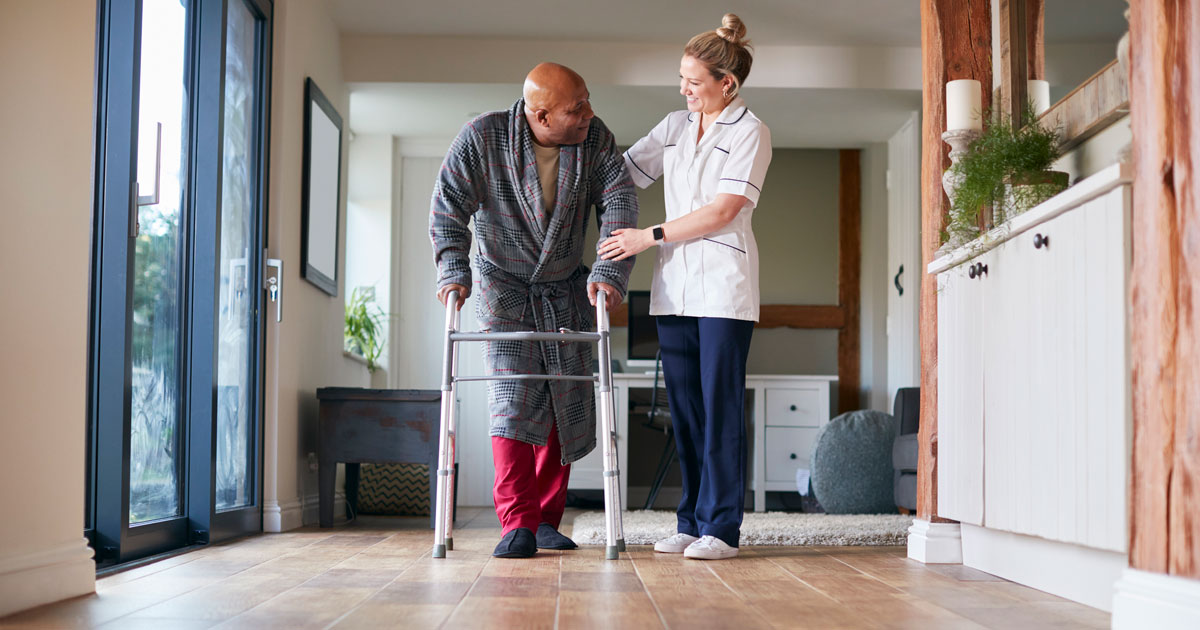
What Is Physical Therapy?
The practice of physical therapy is the treatment of disease, injury, or deformity by physical methods such as exercise, massage, and heat treatment rather than through surgery or medications. It can also be used for health maintenance or injury prevention, rather than as a reactive measure to correct an adverse condition.
Physical therapy can take many forms and can be modified to treat different types of people depending on their job, daily activities, age, or goals. Below, we take a look at how physical therapy can be utilized by those who are over 60 years old.
How Does Physical Therapy Help the Elderly?
Physical therapy for seniors can play an integral role in keeping them physically healthy, active, independent, and safe as they age. When used as a preventative tool, physical therapy can provide seniors with more mobility, strength, and confidence while helping them reduce the risk of falls and other physical ailments. It can also be deployed for the recovery of injuries, illnesses, and strokes.
Here are five key benefits for physical therapy for seniors:
- Improved Mobility: In later stages of life, mobility begins to decrease for a variety of reasons. Advanced age often results in reduced lean muscle mass and tissue, less bone density (leading to osteoporosis), degraded cartilage (which often leads to arthritis), and the accumulation of injuries of varying degrees over the years. Lack of mobility, especially after a hospital stay or an injury, can lead to the development of acute infections or pressure ulcers, or even lead to pneumonia. By focusing on mobility exercises, physical therapy can allow the patient to increase their activity, reduce the risk of acute injuries, and help them maintain their health.
- Preventing Falls: Seniors are significantly more at-risk for falls because of age-related conditions such as less physical strength, difficulties with walking and balance, vision problems, and more. Complicating things further, falls pose a significant risk to seniors as it can immobilize them and cause a domino effect of other physical problems. According to the CDC, 3 million older people are treated in emergency departments for fall injuries each year, and one out of every five falls causes a serious injury such as broken bones or a head injury. In addition, more than 95% of hip fractures are caused by falling. Through physical therapy, seniors can improve their balance, coordination, strength, and functionality of their joints and muscles to help prevent falls and reduce the risk of serious injury should a fall occur.
- Decreased Pain: Physical therapy can be a tool for alleviating pain, especially when surgeries or pain relievers are not viable options. Depending on the ailment, a physical therapist can apply intentional techniques that can improve range of motion and reduce swelling. Additional techniques such as massage therapy, heat therapy, cold therapy, and electrical stimulation therapy have all demonstrated the potential to provide pain relief for a variety of conditions that affect seniors as well.
- Improvement of Age-Related Conditions and Symptoms: As health issues arise in advanced age, it is important to find effective and sustainable methods of treatment and management. Physical therapy has proven to be helpful with managing osteoporosis, dealing with the difficult side effects of cancer treatments, helping senior women reduce levels of incontinence, and more. Physical therapy has also been utilized for physical improvement or management related to arthritis, strokes, Alzheimers, Parkinson's disease, and Chronic obstructive pulmonary disease (COPD).
- Independence and Quality of Life: Activity may decrease with age, often resulting in an increase of health issues. When used as a regular part of a senior's health care efforts, physical therapy can help a patient solidify their strength, flexibility, balance, and posture so they can continue to live active and independent lives. This freedom of movement — and fewer restrictions due to physical issues — can help seniors have more satisfaction in their daily lives. It can also give them the confidence they need to live their lives more fully, and reduce their fears of fall-related injuries.

Can You Get Physical Therapy at Home?
Some older patients who need physical therapy may have limited mobility or difficulty getting themselves to a clinic for physical therapy. Fortunately, a doctor can provide a referral for physical therapy in the home so patients can receive necessary treatment without stepping outside. This is highly common for the elderly population as they recover from surgeries, strokes, fractures, heart attacks, or other physical disorders. In-home physical therapists can bring necessary equipment with them to ensure an effective treatment session within the patient's home. Physical therapy in home settings can also make the patient more comfortable and willing to make the investment into treating and improving their condition.
An added benefit of having a physical therapist come to a patient's home is they can make recommendations on how to optimize the home for safety. This may involve rearranging furniture placements and other items in the home to promote better flow, or something more substantial such as home modifications or adaptive equipment. These changes should help reduce risks of injuries or falling in the home and help foster a safer home environment for the patient.
Learn more about Keystone Health's in-home physical therapy.
Choosing a Physical Therapist
There are several factors that come into play when it is time to choose a physical therapist. First and foremost is their experience and expertise in the condition that you want them to help you with. So while your healthcare provider might have a list of physical therapists they work with, not all of them are created equal. You will want to make sure that what they offer is aligned with what you need. You also want to find out whether or not they accept your insurance.
Another consideration is location. Will you have to go to their clinic, a gym, or a recreation center — or will they come to your home? And wherever the session takes place, will all of the necessary equipment be already on hand, or will you have to make arrangements?
Finally, there is the matter of whether or not you are a good fit for each other. Physical therapy can be painful and frustrating. It is important to be able to work effectively with your physical therapist so that they can help you achieve your goals.
What to Expect at Your First Physical Therapy Appointment
After you have selected your physical therapist, the next phase of the process can begin. If possible, you should communicate all of your needs to your therapist so that they can let you know if there is anything you need to do to prepare for your first session.
Often times, this means putting together information about your medical history, tracking down any X-rays or MRIs that might be relevant, making a list of your medications, and writing out any and all aches and pains you are experiencing — whether they are temporary or chronic.
You will also want to have a clear sense of your health goals in seeking treatment. This can help your physical therapist develop the plan that is most appropriate for your condition.

Your First Physical Therapy Session
Do not be surprised if you find your first physical therapy session to be less active than you imagined it would be. The first session will consist of what is called an initial assessment. This includes a series of questions about your health, lifestyle, and medical history. Some of these topics may have been covered during your initial discussions with your therapist, but it is always good to talk through them again in case you have remembered something that you need to report, or you need to clarify something for the sake of accuracy.
After sharing all of this information, your therapist will conduct a thorough exam. The specifics will depend about your particular condition, but it could include anything from strength and flexibility exercises, checks on your posture, coordination, and reflexes, or measuring your blood pressure, heart rate, and respiration rate.
You might also be asked to walk, sit on the floor and stand back up, or perform other types of body movements that help your therapist get a better sense of your mechanics. Because of this it is important to be appropriately dressed. You want to wear comfortable shoes and clothes that do not restrict your range of motion.
In some cases, the initial assessment is enough to lead your therapist to a specific diagnosis, and in others, they will have to draw educated inferences about what you are experiencing and how they can help you achieve your goals. They will share their knowledge with you so that you can understand what is going on, too, so it is a good idea to come prepared to take notes that you can refer back to later.
Physical Therapy Treatment Plans and Beyond
It is likely that some form of exercise will be included in your treatment plan. One of the best ways to reduce pain is to find out what part of the body is causing it (for example, your back pain might be the result of how you have been walking ever since suffering a knee injury) and carefully improve the mechanics of that area. This often means improving muscle strength with weight exercises or improving flexibility and blood flow through stretching. Aerobic exercises are also common.
A different branch of the therapeutic tree is to correct issues that have developed over a long period of time. If your posture is giving you neck pain, you might need to wear a brace to retrain your body so that your back is under less strain. Alternatively, you might be asked to make a lifestyle change, like going on two twenty minute walks each day to keep your heart more active.
This brings up the at-home component of care. Not everything you have on your treatment plan will be worked through during your sessions. You will likely be given homework, and it is important that you do it. A treatment plan can only be successful to the extent that it is followed. But, as is always the case, it is also important not to overdo it. While it is okay to feel exhausted or sore after therapy, you should stop at the first sign of pain.
Lastly, your physical therapist might recommend that you either apply heat or cold to certain parts of your body. These therapies can improve blood flow, reduce swelling, and decrease the amount of soreness you feel between sessions and home exercises.
With all of these different approaches to helping you achieve your goals taken together, you will be well on your way to experiencing a better overall quality of life.
What Is a Senior Physical Therapist?
Also known as a geriatric physical therapist, a senior physical therapist is a qualified physical therapist that specializes in treatments for conditions that commonly affect older adults. By focusing on age-related issues, a senior physical therapist can approach therapeutic options in a way that is informed and catered to an older segment of the population with a better understanding of their specific needs.
How Much Does a Geriatric Physical Therapist Make?
According to Zippia, geriatric physical therapists make an average of $83,733 a year (or an average of $40.26 an hour). They also indicate that geriatric physical therapy as a career option is expected to grow 22% by 2028, producing 54,200 job opportunities in the United States.
Conclusion
Physical therapy is essential for seniors in helping to maintain their health and manage their ailments as they advance in age. From pain management, to improving physical capabilities, treating adverse conditions, and reducing the risk of injury, physical therapy for seniors is an excellent non-surgical, non-drug option for improving health and well-being.
